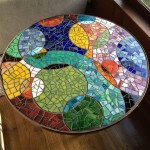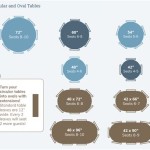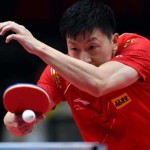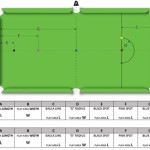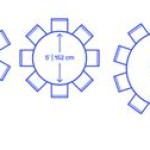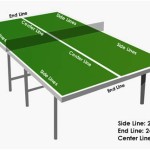Ping Pong Table Regulation Size: A Comprehensive Guide
The game of ping pong, also known as table tennis, has a rich history and enjoys worldwide popularity, both recreationally and competitively. A critical component of the game is the table itself. However, not any flat surface will suffice. Official tournaments and sanctioned matches require adherence to a specific set of dimensional standards. This article will delve into the regulation size of a ping pong table, exploring each dimension in detail and discussing the importance of these measurements for gameplay and fair competition.
Understanding the precise dimensions of a regulation ping pong table is essential for manufacturers, players aiming to improve their game, and organizers of tournaments. Deviations from these standards can impact the ball's bounce, the speed of play, and the overall fairness of the game. Therefore, it is vital to be familiar with the established guidelines set forth by governing bodies such as the International Table Tennis Federation (ITTF).
The standardized dimensions of a ping pong table are designed to provide a consistent playing surface that promotes a level playing field for all participants. These measurements impact not only the physical space required for the table but also the strategic aspects of the game. For instance, the length of the table influences the type of shots players can effectively execute, while the height impacts the trajectory of the ball and the player's ability to return serves.
The ITTF is the internationally recognized governing body for all table tennis associations. They are very clear on the dimensional standards for competitive table tennis. These are the standards used for the Olympics and professional table tennis events.
Length and Width of the Playing Surface
The most fundamental aspect of a regulation ping pong table is its overall size. According to ITTF regulations, a standard ping pong table must measure 2.74 meters (9 feet) in length and 1.525 meters (5 feet) in width. These dimensions have been established through years of refinement and are deemed optimal for both singles and doubles play. The rectangular shape provides ample space for players to maneuver and execute a wide range of shots, including forehand drives, backhand blocks, and strategic serves.
The length of the table is crucial for determining the trajectory and speed of the ball. A longer table allows for longer rallies and encourages players to develop skills in shot placement and spin variation. The width of the table, on the other hand, influences the angle at which players can hit the ball and the defensive coverage required. Players need to be adept at covering the entire width of the table to effectively return shots from varying angles. Deviations from these standard dimensions can significantly alter the dynamics of the game, potentially favoring certain playing styles or skill sets.
The precision of these measurements is paramount, which is why manufacturers of professional-grade ping pong tables adhere to strict quality control procedures. Even slight variations in length or width can affect the bounce of the ball and impact the fairness of the game. The playing surface must be perfectly rectangular and free from any warps or irregularities that could compromise the integrity of the match. This precision ensures that players can rely on the table to perform consistently and predictably, allowing them to focus on their strategy and execution.
For recreational play, minor differences in length or width are not as critical, but adhering to the regulation sizes is recommended when practicing for tournaments or improving one's game. Often, home tables are built smaller to accommodate space requirements. While this is appropriate for casual play, players should be aware of the differences in size before competing.
Height of the Table and the Net
In addition to the length and width, the height of a regulation ping pong table is also precisely defined. The top surface of the table must be 76 centimeters (30 inches) above the floor. This height is considered ideal for allowing players to comfortably strike the ball while maintaining a good posture and balance. Too high and players are reaching, too low and players are crouching leading to discomfort and poor form.
The height of the table is intrinsically linked to the height of the net. The net, which divides the table into two equal halves, must be 15.25 centimeters (6 inches) high. This net height ensures that the ball has sufficient clearance when passing over the net during serves and rallies. Achieving the correct net height requires precise measurements and a proper net attachment mechanism. A net that is too low can result in serves being incorrectly called "in," while a net that is too high can make it difficult to return the ball effectively.
The combination of table height and net height creates a specific parameter for the trajectory of the ball during play. Players must adjust their strokes and angles to account for these measurements, developing the ability to hit over the net accurately and strategically. Different playing styles, such as topspin and backspin, rely heavily on the precise net height to generate the desired ball trajectory and spin. Therefore, adhering to the standard height regulations is crucial for mastering the nuances of the game.
Many commercially available ping pong tables come with adjustable feet, which allow players to level the table and ensure it is at the correct height. This is particularly important when playing on uneven surfaces, as even slight variations in height can affect the bounce of the ball and the overall playing experience. Using a level to check the table’s height is good practice before starting a competitive game.
Surface Color and Material
While the dimensions of a ping pong table are critical, the color and material of the playing surface also play a significant role. According to ITTF regulations, the table surface must be dark colored, usually green or blue, and matte. The matte finish is essential for reducing glare and providing good visibility of the ball's trajectory. Glossy surfaces can reflect light, making it difficult for players to track the ball accurately, especially under bright lighting conditions.
The surface of the table is typically made of a composite wood material, such as medium-density fiberboard (MDF), that provides a consistent and uniform bounce. The thickness of the playing surface can vary, but it is generally between 16mm and 25mm. A thicker surface tends to offer a more predictable bounce and is less prone to warping or damage. High-quality ping pong tables often feature a multi-layer construction that combines MDF with other materials, such as wood veneer or laminate, for added durability and performance.
For the table to be considered a regulation surface, the surface is uniformly colored and finished, providing that the whole surface will reflect the ball predictably. The table surface must react predictably with the ball, and the material and finish of the table surface impact this predictable reaction. A surface that has uneven or non-standard behavior will not meet regulation requirements.
The lines painted on the surface of the table are also subject to specific regulations. A white line, 2 cm (0.8 inches) wide, runs along each long edge of the table. In doubles play, a white centerline, 3 mm (0.12 inches) wide, divides each half of the table into equal courts. These lines help players to determine the legality of serves and the correct positioning during doubles matches. The lines must be clearly visible and accurately placed to ensure fair play.
Regulation ping pong tables are designed and manufactured to meet exacting standards, ensuring that players can compete on a level playing field. The dimensions, color, and material of the table all contribute to the overall playing experience and affect the strategic aspects of the game. By adhering to these regulations, players can focus on honing their skills and enjoying the sport to its fullest.

To Choose The Right Table Tennis Size For You Stiga Sports

Md Sports Official Size Table Tennis Com

Table Tennis Dlgsc

Ping Pong Table Dimensions Ponghero

Indoor Outdoor Foldable Mobile Table Tennis Cuu43327489 The Home Depot

To Choose The Right Table Tennis Size For You Stiga Sports

Table Tennis Measurements Size And Dimensions Cornilleau

Md Sports Official Size 15 Mm 4 Piece Indoor Table Tennis Accessories Included Com

Official Size Indoor Tennis Ping Pong Table 2 Paddles And Balls Included

Ping Pong Table Dimensions The Guy
Related Posts


